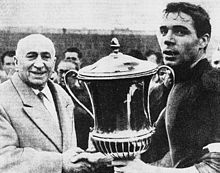Mitropa Cup
[citation needed] The idea of a European cup competition was shaped after World War I which brought the defeat and collapse of the Austro-Hungarian Empire.
In order to strengthen the dominance of these countries in European football and to financially support the professional clubs, the introduction of the Mitropa Cup was decided at a meeting in Venice on 17 July, following the initiative of the head of the Austrian Football Association (ÖFB), Hugo Meisl.
Initially two teams each from Austria, Hungary, Czechoslovakia and Yugoslavia entered, competing in a knock-out competition.
In 1939, prior to the start of World War II, the cup involved only eight teams (two each from Hungary, Czechoslovakia and Italy and one each from Romania and Yugoslavia).
[citation needed] A tournament was started in 1940, but abandoned before the final match due to World War II.
Hungarian Ferencváros and Romanian Rapid (which had won on lots after three draws) qualified for the final, but did not meet because the northern part of Transylvania (lost shortly after World War I) was ceded to Hungary from Romania.

